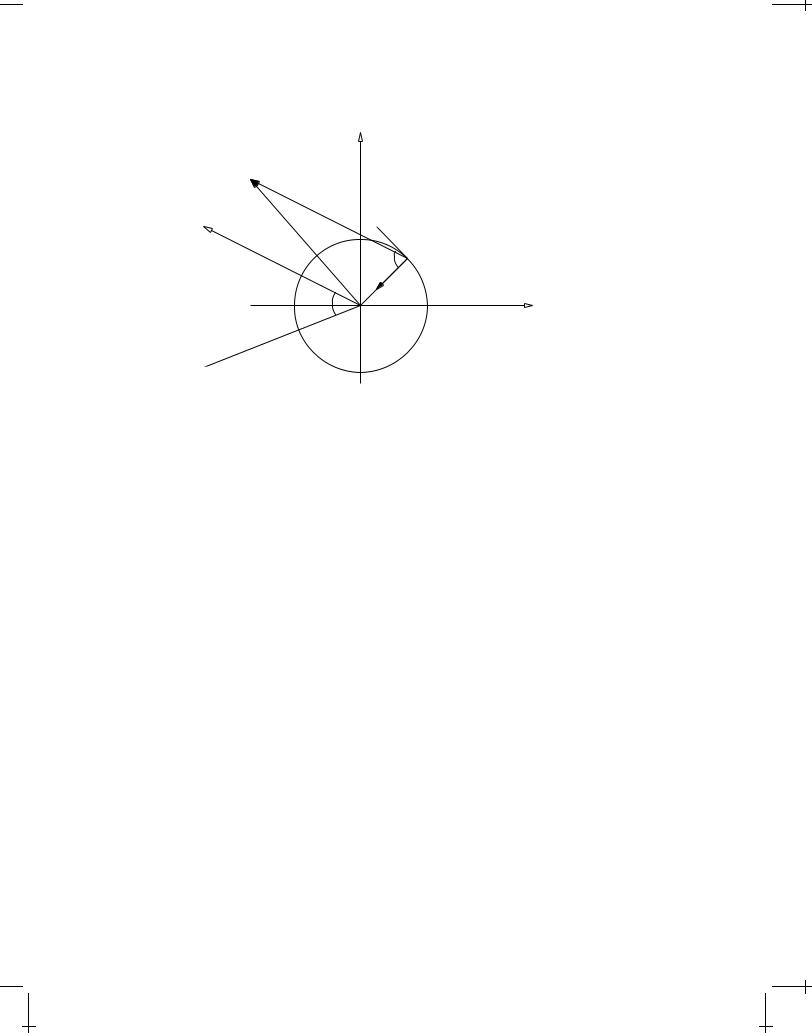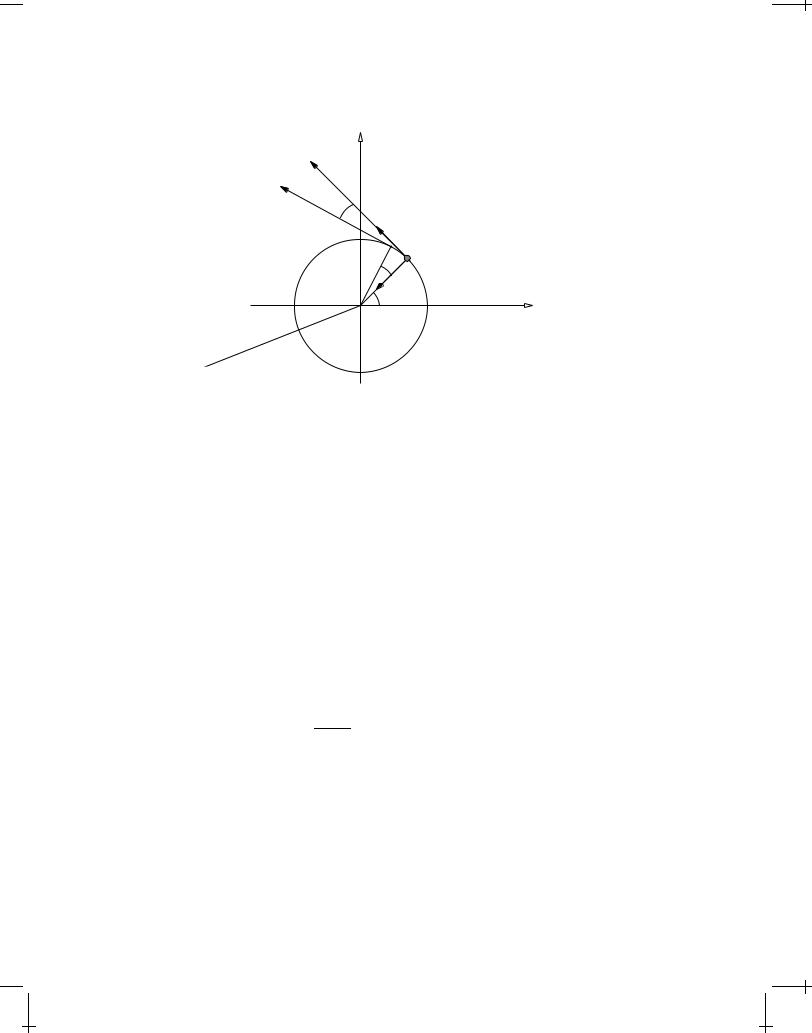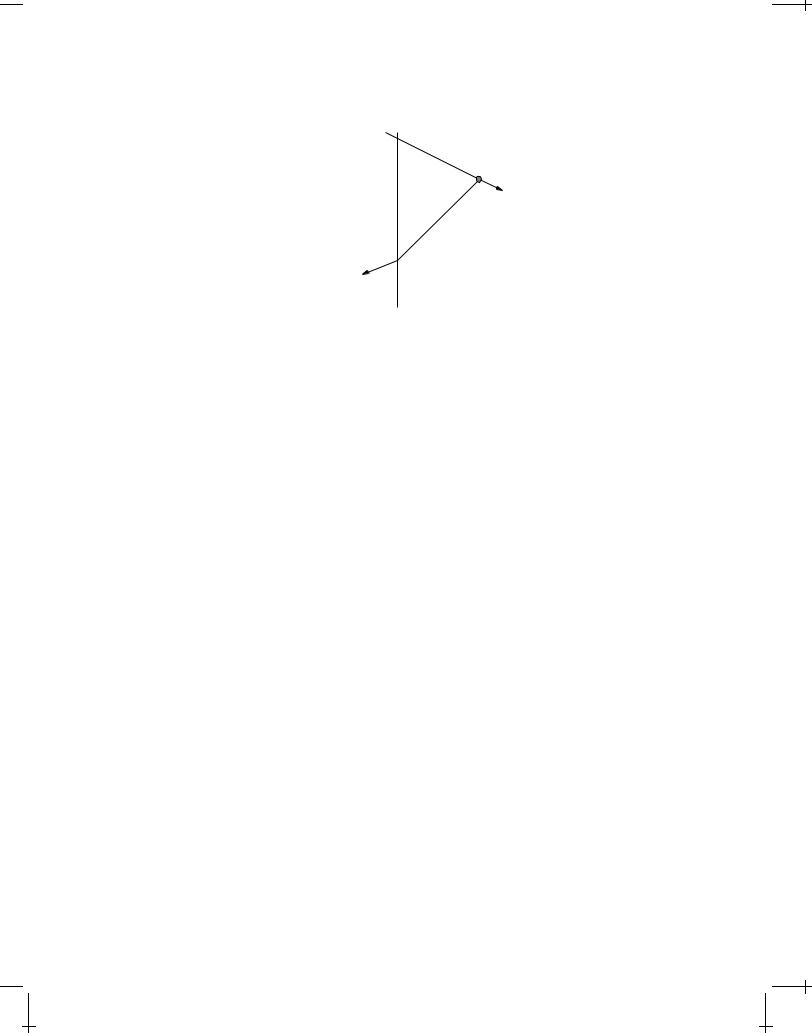
electrodynamics / Electromagnetic Field Theory - Bo Thide
.pdf
8.5 RADIATION FROM A LOCALISED CHARGE IN ARBITRARY MOTION |
133 |
|
x2
(t;x) |
x x0 |
|
|
|
x |
 v
v
q0
 (t0;x0)
(t0;x0)
a
v˙
 '(t0)
'(t0)
0 |
x1 |
 x3
x3
FIGURE 8.6: Coordinate system for the radiation from a charged particle at x0(t0) in circular motion with velocity v(t0) along the tangent and constant acceleration v˙(t0) toward the origin. The x1 x2 axes are chosen so that the relative field point vector x x0 makes an angle with the x3 axis which is normal to the plane of the orbital motion. The radius of the orbit
is a.
where the retarded distance s is given by expression (8.64) on page 113. With the radiation part of the electric field, expression (8.87) on page 119, inserted, and using (8.154a) and (8.154b) on the facing page, one finds, after some algebra, that
|
|
|
2 |
|
|
|
|
v |
|
#2 |
|
|
|
v2 |
2 |
|
2 |
|
|
dUrad(;') |
|
0q0 |
v˙ |
|
|
1 |
c sin cos' |
|
c2 |
sin |
sin |
|
|
|
|||||
= |
|
2 |
|
1 |
|
' |
(8.157) |
||||||||||||
dt0 |
16 2c " |
|
v |
|
|
|
#5 |
|
|
|
|||||||||
|
" |
|
|
|
|
|
|
|
|
|
|||||||||
|
|
|
|
|
|
|
|
1 |
c sin cos ' |
|
|
|
|
|
|||||
The angles and ' vary in time during the rotation, so that refers to a moving coordinate system. But we can parametrise the solid angle d in the angle ' and the (fixed) angle so that d=sin d d'. Integration of Equation (8.157) above over this d gives, after some cumbersome algebra, the angular integrated expression
dU˜ rad |
= |
0q02v˙2 |
1 |
|
(8.158) |
|
dt0 |
6 c |
|
1 cv22 |
2 |
||
|
|
|
||||
|
|
|
|
|||
Draft version released 13th November 2000 at 22:01. |
Downloaded from http://www.plasma.uu.se/CED/Book |
|
|

134 |
ELECTROMAGNETIC RADIATION |
|
In Equation (8.157) on the preceding page, two limits are particularly interesting:
1.v=c 1 which corresponds to cyclotron radiation.
2.v=c j 1 which corresponds to synchrotron radiation.
Cyclotron radiation
For a non-relativistic speed v c, Equation (8.157) on the previous page reduces to
|
dUrad(;') |
|
0q02v˙2 |
|
|
|
|
= |
|
(1 sin2 sin2 ') |
(8.159) |
|
dt0 |
16 2c |
|||
But, according to Equation (8.154b) on page 132 |
|
||||
sin2 sin2 ' = cos2 |
(8.160) |
||||
where is defined in Figure 8.5.4 on the previous page. This means that we can write
dUrad( ) |
= |
0q02v˙2 |
(1 cos2 ) = |
0q02v˙2 |
sin2 |
(8.161) |
|
dt0 |
|
16 2c |
16 2c |
||||
Consequently, a fixed observer near the orbit plane will observe cyclotron radiation twice per revolution in the form of two equally broad pulses of radiation with alternating polarisation.
Synchrotron radiation
When the particle is relativistic, v j c, the denominator in Equation (8.157) on the preceding page becomes very small if sin cos' 1, which defines the forward direction of the particle motion ( =2; ' 0). Equation (8.157) on the previous page then becomes
dUrad(=2;0) |
0q02v˙2 |
1 |
(8.162) |
||||
|
= |
|
|
|
|
||
dt0 |
16 2c " |
v 3 |
|||||
|
|
||||||
|
1 |
c # |
|
||||
which means that an observer near the orbit plane sees a very strong pulse followed, half an orbit period later, by a much weaker pulse.
The two cases represented by Equation (8.161) and Equation (8.162) above are very important results since they can be used to determine the characteristics of the particle motion both in particle accelerators and in astrophysical objects where a direct measurement of particle velocities are impossible.
Downloaded from http://www.plasma.uu.se/CED/Book |
Draft version released 13th November 2000 at 22:01. |
|
|

8.5 RADIATION FROM A LOCALISED CHARGE IN ARBITRARY MOTION |
135 |
|
x2
(t;x)
x x0
|
v |
|
q0 |
a |
(t0;x0) |
|
v˙ |
0 |
'(t0) |
x1 |
 x3
x3
FIGURE 8.7: When the observation point is in the plane of the particle orbit, i.e., = =2 the lobe width is given by .
In the orbit plane ( = =2), Equation (8.157) on page 133 gives
|
|
|
|
|
|
|
|
|
2 |
|
|
|
v |
#2 |
|
|
|
|
v2 |
2 |
|
|
dUrad |
( =2;') |
|
|
0q0 |
v˙2 |
1 |
c cos ' |
|
c2 |
sin |
|
|
||||||||||
= |
|
|
1 |
' |
(8.163) |
|||||||||||||||||
|
|
|
|
|
|
|
|
|
|
|
|
|
|
|
|
|
|
|||||
|
dt0 |
16 2c " |
|
|
v |
|
|
|
|
|||||||||||||
|
|
|
" |
|
|
|
#5 |
|
|
|
||||||||||||
|
|
|
|
|
|
|
|
|
|
|
|
|
1 |
c cos ' |
|
|
|
|
|
|||
which vanishes for angles '0 such that |
|
|
|
|
|
|
|
|
|
|||||||||||||
cos '0 |
= |
v |
|
|
|
|
|
|
|
|
|
|
|
|
|
|
|
|
|
|
(8.164a) |
|
c |
|
|
|
|
|
|
|
|
|
|
|
|
|
|
|
|
||||||
|
|
|
|
|
|
|
|
|
|
|
|
|
|
|
|
|
|
|
|
|||
|
|
|
|
|
|
|
|
|
|
|
|
|
|
|
|
|
|
|
|
|
|
|
|
sin '0 |
= 1 |
v2 |
|
|
|
|
|
|
|
|
|
|
|
|
|
(8.164b) |
|||||
|
c2 |
|
|
|
|
|
|
|
|
|
|
|
|
|
|
|||||||
Hence, the angle '0 is a measure of the synchrotron radiation lobe width ; see Figure 8.5.4. For ultra-relativistic particles, defined by
= |
? 1 |
|
|
1; 1 |
|
v2 |
1; |
(8.165) |
|||||||
|
|
|
|
c2 |
|||||||||||
1 |
v2 |
|
|||||||||||||
|
c2 |
|
|||||||||||||
one can approximate |
|
|
|
|
|
|
|
||||||||
|
|
|
|
|
|
|
|
|
|
|
|
|
|
|
|
'0 sin'0 = 1 |
v2 |
|
= |
|
1 |
|
|
|
(8.166) |
||||||
c2 |
|
|
|
||||||||||||
Draft version released 13th November 2000 at 22:01. |
Downloaded from http://www.plasma.uu.se/CED/Book |
|
|

136 |
ELECTROMAGNETIC RADIATION |
|
Hence, synchrotron radiation from ultra-relativistic charges is characterized by a radiation lobe width which is approximately
|
|
1 |
|
|
|
|
(8.167) |
|
|
|
|
||||||
This angular interval is swept by the charge during the time interval |
|
|||||||
t0 = |
|
|
|
|
|
|
(8.168) |
|
!0 |
|
|
|
|||||
|
|
|
|
|
||||
during which the particle moves a length interval |
|
|||||||
l = v t0 = v |
|
(8.169) |
||||||
!0 |
|
|||||||
|
|
|
|
|
|
|
|
|
in the direction toward the observer who therefore measures a pulse width of length
t =t0 |
|
l |
=t0 |
|
|
|
v t0 |
= 1 |
|
|
|
|
v |
t0 = 1 |
|
|
v |
|
1 |
|
v 1 |
|||||||||||||||||
|
|
|
|
|
|
|
|
|
|
|
|
|
|
|
|
|
|
|
|
|
|
|
||||||||||||||||
|
c |
|
|
|
|
c !0 |
|
c !0 |
||||||||||||||||||||||||||||||
|
|
|
c |
|
|
|
c |
|
|
|
||||||||||||||||||||||||||||
1 |
v |
|
|
1 + v |
|
|
1 |
|
|
|
|
v |
2 |
|
|
1 |
|
1 |
|
1 |
|
|
|
|
|
|
|
|
|
|||||||||
= |
" |
c #" c # |
|
1 |
|
|
|
|
= |
|
|
|
|
|
|
|
|
|
|
|||||||||||||||||||
|
|
|
|
|
|
|
|
|
|
|
|
|
|
|
|
|
|
|||||||||||||||||||||
|
|
|
|
|
|
v |
|
|
|
|
|
*+-,. |
|
|
|
|
|
|
|
|
|
|
|
|
|
|
|
|
|
|
||||||||
|
|
1 |
|
|
|
|
!0 |
c2 |
|
|
2!0 |
|
2 3 !0 |
|
|
|
|
|
|
|
||||||||||||||||||
|
|
|
|
|
|
|
|
|
|
|
|
|
|
|
|
|||||||||||||||||||||||
|
|
*+/,c. |
|
|
|
|
|
|
|
|
|
|
|
|
|
|
|
|
|
|
|
|
|
|
|
|
|
|
|
|
|
|
|
|||||
|
|
|
|
|
|
|
1=2 |
|
|
|
|
|
|
|
|
|
|
|
|
|
|
|
|
|
|
|
|
|||||||||||
|
|
|
2 |
|
|
|
|
|
|
|
|
|
|
|
|
|
|
|
|
|
|
|
|
|
|
|
|
|
||||||||||
|
|
|
|
|
|
|
|
|
|
|
|
|
|
|
|
|
|
|
|
|
|
|
|
|
|
|
|
|
(8.170) |
|||||||||
|
|
|
|
|
|
|
|
|
|
|
|
|
|
|
|
|
|
|
|
|
|
|
|
|
|
|
|
|
|
|
|
|
|
|||||
As a general rule, the spectral width of a pulse of length t is ! j 1= t. In the ultra-relativistic synchrotron case one can therefore expect frequency components up to
!max |
1 |
= 2 3!0 |
(8.171) |
t |
A spectral analysis of the radiation pulse will exhibit Fourier components n!0 from n = 1 up to n 2 3.
When N electrons are contributing to the radiation, we can discern between three situations:
1.All electrons are very close to each other so that the individual phase differences are negligible. The power will be multiplied by N2 relative to a single electron and we talk about coherent radiation.
Downloaded from http://www.plasma.uu.se/CED/Book |
Draft version released 13th November 2000 at 22:01. |
|
|

8.5 RADIATION FROM A LOCALISED CHARGE IN ARBITRARY MOTION |
137 |
|
2. The electrons are perfectly evenly distributed in the orbit. This is the case, for instance, for electrons in a circular current in a conductor. In this case the radiation fields cancel completely and no far fields are generated.
3. The electrons are unevenly distributed in the orbit. This happens for an p
open ring current which is subject to fluctuations of order N as for all open systems. As a result we get incoherent radiation. Examples of this can be found both in earthly laboratories and under cosmic conditions.
Radiation in the general case
We recall that the general expression for the radiation E field from a moving charge concentration is given by expression (8.87) on page 119. This expression in Equation (8.156) on page 132 yields the general formula
dUrad( ) |
|
0q0 |
2 |
jx |
x0j |
|
|
|
|
|
|
|
|
|
jx x0jv |
|
|
2 |
||||||||
= |
|
(x |
|
x0) |
|
(x |
|
x0) |
|
|
v˙ |
(8.172) |
||||||||||||||
|
dt0 |
|
|
|
|
|||||||||||||||||||||
|
|
|
16 |
|
cs |
5 |
|
|
|
|
|
c |
|
|
||||||||||||
|
|
|
|
|
|
|
|
2 |
|
|
|
|
|
|
|
|
|
|
|
|
|
|
|
|||
|
|
|
|
|
|
|
|
|
|
|
|
|
|
|
|
|
|
|
|
|
|
|
|
|
|
|
Integration over the solid angle gives the totally radiated power as |
||||||||||||||||||||||||||
|
dU˜ rad |
|
|
0q0 |
2 |
v˙ |
2 |
|
|
v2 |
2 |
|
|
|
|
|
|
|
|
|
|
|||||
|
= |
|
|
1 c2 sin |
|
|
|
|
|
|
|
|
|
(8.173) |
||||||||||||
|
|
dt0 |
6 c |
|
|
|
|
3 |
|
|
|
|
|
|
|
|
|
|||||||||
|
|
|
|
|
|
|
1 cv22 |
|
|
|
|
|
|
|
|
|
|
|
||||||||
|
|
|
|
|
|
|
|
|
|
|
|
|
|
|
|
|
|
|||||||||
where is the angle between v and v˙.
In the limit v kv˙, sin =0, which corresponds to bremsstrahlung. For v ?v˙, sin = 1, which corresponds to cyclotron radiation or synchrotron radiation.
Virtual photons
According to formula (8.98a) on page 122 and Figure 8.5.4 on the next page
|
q0 |
|
|
|
|
|
v2 |
|
|
|
|
||||
E? = Ez = |
|
|
1 |
|
(x x0) xˆ3 |
||||||||||
4"0 s3 |
c2 |
||||||||||||||
|
q0 |
|
|
|
|
|
|
|
|
b |
|
|
(8.174) |
||
= |
|
|
|
|
|
|
|
|
|
|
|
|
|||
4" |
|
|
2 |
(vt) |
2 |
|
|
2 |
= |
2 3=2 |
|
||||
|
|
|
|
|
|||||||||||
|
|
0 |
|
|
|
|
|
|
|
+ |
|
|
|
|
|
which represents a contracted field, approaching the field of a plane wave. The passage of this field “pulse” corresponds to a frequency distribution of the field energy. Fourier transforming, we obtain
E!;? = |
1 1 |
E?(t)e |
i!t |
dt = |
q |
|
|
b! |
K1 |
b! |
(8.175) |
||
|
|
|
|
|
|
|
|
|
|||||
2 |
|
4 2" |
bv |
v |
v |
||||||||
|
|
1 |
|
|
|
0 |
|
|
|
|
|
|
|
Draft version released 13th November 2000 at 22:01. |
Downloaded from http://www.plasma.uu.se/CED/Book |
|
|

138 |
ELECTROMAGNETIC RADIATION |
|
vt
q0
b |
v =vxˆ |
|
B
 E?zˆ
E?zˆ
FIGURE 8.8: The perpendicular field of a charge q0 moving with velocity v = vxˆ is E?zˆ.
Here, K1 is the Kelvin function (Bessel function of the second kind with imaginary argument) which behaves in such a way for small and large arguments that
E!;? |
q |
; b! v |
(8.176a) |
|
4 2"0bv |
|
|||
E!;? 0; b! v |
(8.176b) |
|||
showing that the “pulse” length is of the order b=v .
Due to the equipartition of the field energy into the electric and magnetic fields, the total field energy can be written
U = "0 |
E2 |
d3x0 |
= "0 |
bmax |
1 |
E2 |
vdt 2 b db |
(8.177) |
V |
? |
|
b |
min |
|
? |
|
|
|
|
|
|
1 |
|
|
|
where the volume integration is over the plane perpendicular to v. With the use of Parseval's identity for Fourier transforms, formula (8.12) on page 101, we can rewrite this as
|
1 |
|
|
|
bmax |
1 |
E |
|
2 |
|
U = U d! = 4 " |
v |
|
!;? |
d!2 b db |
||||||
|
0 |
|
0 |
|
bmin |
0 |
|
(8.178) |
||
|
q2 |
1 v =! db |
|
|
|
|||||
|
|
|
|
|
||||||
|
|
|
|
|
d! |
|
|
|
||
2 2"0v |
0 |
bmin |
b |
|
|
|
||||
from which we conclude that
U! |
q2 |
ln |
v |
(8.179) |
|
2 2"0v |
bmin! |
|
|||
Downloaded from http://www.plasma.uu.se/CED/Book |
Draft version released 13th November 2000 at 22:01. |
|
|

8.5 RADIATION FROM A LOCALISED CHARGE IN ARBITRARY MOTION |
139 |
|
where an explicit value of bmin can be calculated in quantum theory only.
As in the case of bremsstrahlung, it is intriguing to quantise the energy into
photons [cf. Equation (8.150) on page 131]. Then we find that |
|
||||||
N! d! |
2 |
ln |
c d! |
(8.180) |
|||
|
|
|
|
|
|||
|
bmin! |
! |
|||||
where = e2=(4 "0hc¯ ) 1=137 is the fine structure constant.
Let us consider the interaction of two electrons, 1 and 2. The result of this interaction is that they change their linear momenta from p1 to p01 and p2 to p02, respectively. Heisenberg's uncertainty principle gives bmin h¯= p1 p01 so that the number of photons exchanged in the process is of the order
N |
|
d! |
|
2 |
ln |
c |
p |
|
p0 |
|
d! |
(8.181) |
|
|
|
|
|||||||||
|
! |
|
|
h¯! 1 |
1 |
! |
|
|||||
Since this change in momentum corresponds to a change in energy h¯! = E1 E10 and E1 = m0 c, we see that
N! d! |
2 |
ln |
0 E1 cp1 cp10 |
|
||||
|
|
m0c2 |
|
E1 E10 |
|
1 |
||
d!
!
(8.182)
a formula which gives a reasonable account of electronand photon-induced processes.
8.5.5 Radiation from charges moving in matter
When electromagnetic radiation is propagating through matter, new phenomena may appear which are (at least classically) not present in vacuum. As mentioned earlier, one can under certain simplifying assumptions include, to some extent, the influence from matter on the electromagnetic fields by introducing new, derived field quantities D and H according to
D = "(t;x)E = "0E |
(8.183) |
B = (t;x)H = m 0H |
(8.184) |
Expressed in terms of these derived field quantities, the Maxwell equations, often called macroscopic Maxwell equations, take the form
r D = (t;x) |
(8.185a) |
||||
r E + |
@ |
|
B = 0 |
(8.185b) |
|
|
@t |
||||
r B = 0 |
(8.185c) |
||||
r H |
@ |
D = j(t;x) |
(8.185d) |
||
@t |
|||||
Draft version released 13th November 2000 at 22:01. |
Downloaded from http://www.plasma.uu.se/CED/Book |
|
|

140 |
ELECTROMAGNETIC RADIATION |
|
Assuming for simplicity that the electric permittivity " and the magnetic permeability , and hence the relative permittivity and the relative permeability m all have fixed values, independent on time and space, for each type of material we consider, we can derive the general telegrapher's equation [cf. Equation (2.26) on page 27]
@2E |
|
@E |
|
@2E |
|
|
|
|
|
" |
|
= 0 |
(8.186) |
@2 |
@t |
@t2 |
||||
describing (1D) wave propagation in a material medium.
In Chapter 2 we concluded that the existence of a finite conductivity, manifesting itself in a collisional interaction between the charge carriers, causes the waves to decay exponentially with time and space. Let us therefore assume that in our medium = 0 so that the wave equation simplifies to
@2E |
" |
@2E |
= 0 |
(8.187) |
@2 |
@t2 |
If we introduce the phase velocity in the medium as
1 |
1 |
|
c |
(8.188) |
||
v' = p |
|
= p |
|
= p |
|
|
" |
"0 m 0 |
m |
||||
where, according to Equation (1.9) on page 5, c =1=p"0 0 is the speed of light, i.e., the phase speed of electromagnetic waves in vacuum, then the general solution to each component of Equation (8.187)
Ei |
= f ( v't) +g( +v't); i = 1;2;3 |
(8.189) |
||||||
The ratio of the phase speed in vacuum and in the medium |
|
|||||||
|
c |
= p |
|
|
= cp |
|
def n |
(8.190) |
|
|
|
" |
|||||
|
v' |
|
||||||
|
|
|
m |
|
|
|
|
|
is called the refractive index of the medium. In general n is a function of both time and space as are the quantities ", , , and m themselves. If, in addition, the medium is anisotropic or birefringent, all these quantities are rank-two tensor fields. Under our simplifying assumptions, in each medium we consider n = Const for each frequency component of the fields.
Associated with the phase speed of a medium for a wave of a given frequency ! we have a wave vector, defined as
def |
ˆ |
|
! v' |
|
||
k |
kk = kvˆ |
' = |
|
|
|
(8.191) |
v' |
v' |
|||||
Downloaded from http://www.plasma.uu.se/CED/Book |
Draft version released 13th November 2000 at 22:01. |
|
|

8.5 RADIATION FROM A LOCALISED CHARGE IN ARBITRARY MOTION |
141 |
|
As in the vacuum case discussed in Chapter 2, assuming that E is time-harmonic, i.e., can be represented by a Fourier component proportional to expfi!tg, the solution of Equation (8.187) can be written
E = E0ei(k x !t) |
(8.192) |
where now k is the wave vector in the medium given by Equation (8.191) on the preceding page. With these definitions, the vacuum formula for the associated magnetic field, Equation (2.33) on page 28,
|
|
|
|
|
v' |
|
|
! |
|
|
|
|
|
B = p |
" |
kˆ |
|
E = |
1 |
kˆ |
|
E = |
1 |
k |
|
E |
(8.193) |
|
|
|
|
|
|||||||||
is valid also in a material medium (assuming, as mentioned, that n has a fixed constant scalar value). A consequence of a 6= 1 is that the electric field will, in general, have a longitudinal component.
It is important to notice that depending on the electric and magnetic properties of a medium, and, hence, on the value of the refractive index n, the phase speed in the medium can be smaller or larger than the speed of light:
v' = |
c |
|
= |
! |
|
(8.194) |
|
n |
k |
||||||
|
|
|
|||||
where, in the last step, we used Equation (8.191) on the preceding page.
If the medium has a refractive index which, as is usually the case, dependent on frequency !, we say that the medium is dispersive. Because in this case also k(!) and !(k), so that the group velocity
vg = |
@! |
(8.195) |
|
|
@k |
||
|
|
|
|
has a unique value for each frequency component, and is different from v'. Except in regions of anomalous dispersion, v' is always smaller than c. In a gas of free charges, such as a plasma, the refractive index is given by the expression
|
!2 |
|
n2 |
(!) = 1 !2p |
(8.196) |
where
å N q2
!2 = (8.197)
p "0m
Draft version released 13th November 2000 at 22:01. |
Downloaded from http://www.plasma.uu.se/CED/Book |
|
|

142 |
ELECTROMAGNETIC RADIATION |
|
is the plasma frequency. Here m and N denote the mass and number density, respectively, of charged particle species . In an inhomogeneous plasma, N = N (x) so that the refractive index and also the phase and group velocities are space dependent. As can be easily seen, for each given frequency, the phase and group velocities in a plasma are different from each other. If the frequency ! is such that it coincides with !p at some point in the medium, then at that point v' ! 1 while vg ! 0 and the wave Fourier component at ! is reflected there.
ˇ
Vavilov-Cerenkov radiation
As we saw in Subsection 8.1, a charge in uniform, rectilinear motion in vacuum does not give rise to any radiation; see in particular Equation (8.98a) on page 122. Let us now consider a charge in uniform, rectilinear motion in a medium with electric properties which are different from those of a (classical) vacuum. Specifically, consider a medium where
" = Const >"0 |
|
(8.198a) |
||||
= 0 |
|
|
|
(8.198b) |
||
This implies that in this medium the phase speed is |
|
|||||
v' = |
c |
1 |
< c |
(8.199) |
||
|
= p |
|
||||
n |
||||||
" 0 |
||||||
Hence, in this particular medium, the speed of propagation of (the phase planes of) electromagnetic waves is less than the speed of light in vacuum, which we know is an absolute limit for the motion of anything, including particles. A medium of this kind has the interesting property that particles, entering into the medium at high speeds jvj, which, of course, are below the phase speed in vacuum, can experience that the particle speeds are higher than the phase
ˇ
speed in the medium. This is the basis for the Vavilov-Cerenkov radiation that we shall now study.
If we recall the general derivation, in the vacuum case, of the retarded (and advanced) potentials in Chapter 3 and the Liénard-Wiechert potentials, Equations (8.63) on page 113, we realise that we obtain the latter in the medium by a simple formal replacement c ! c=n in the expression (8.64) on page 113 for s. Hence, the Liénard-Wiechert potentials in a medium characterized by a
Downloaded from http://www.plasma.uu.se/CED/Book |
Draft version released 13th November 2000 at 22:01. |
|
|
